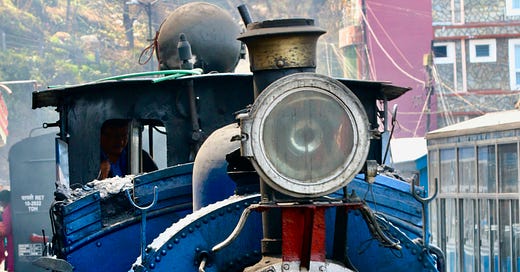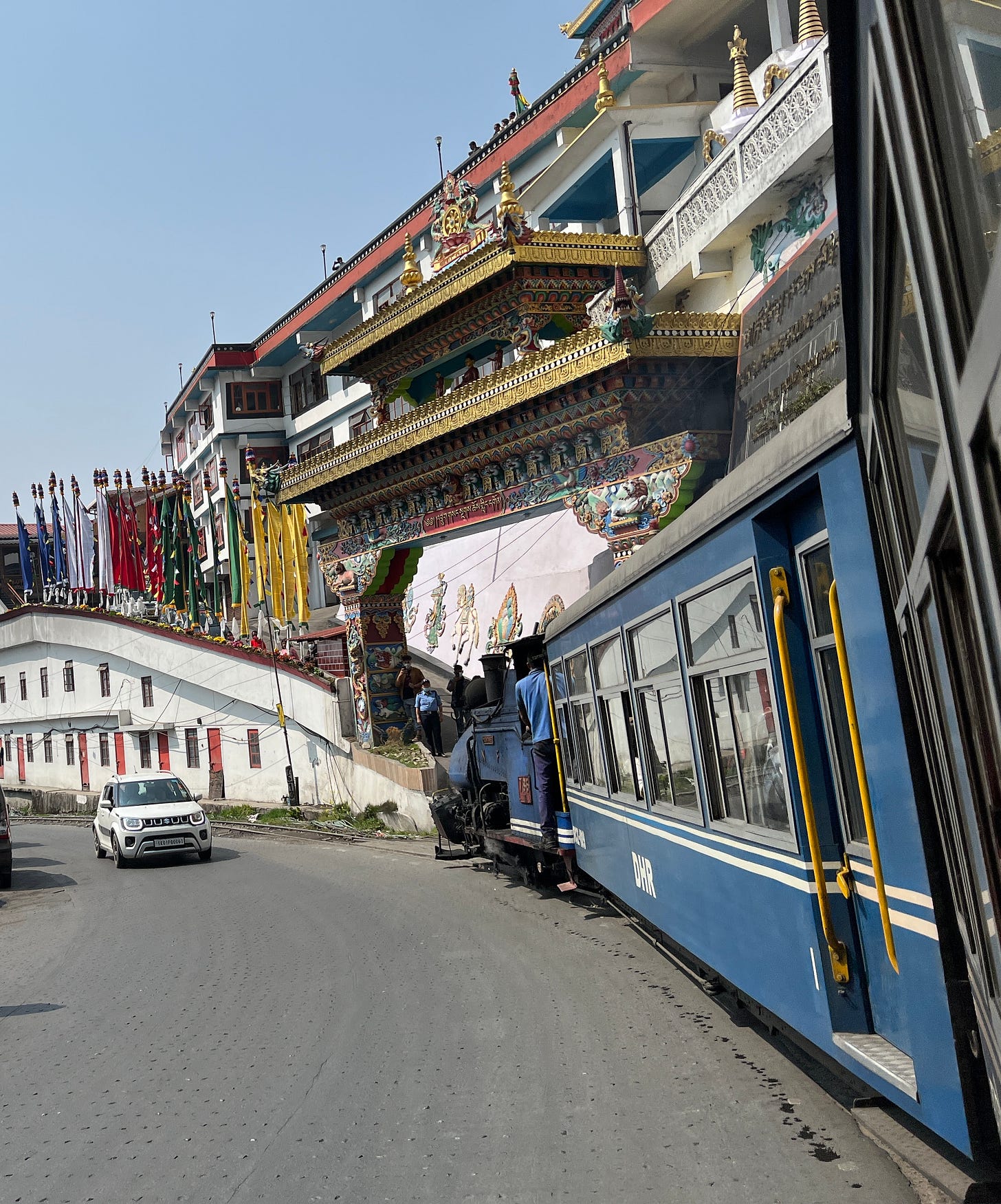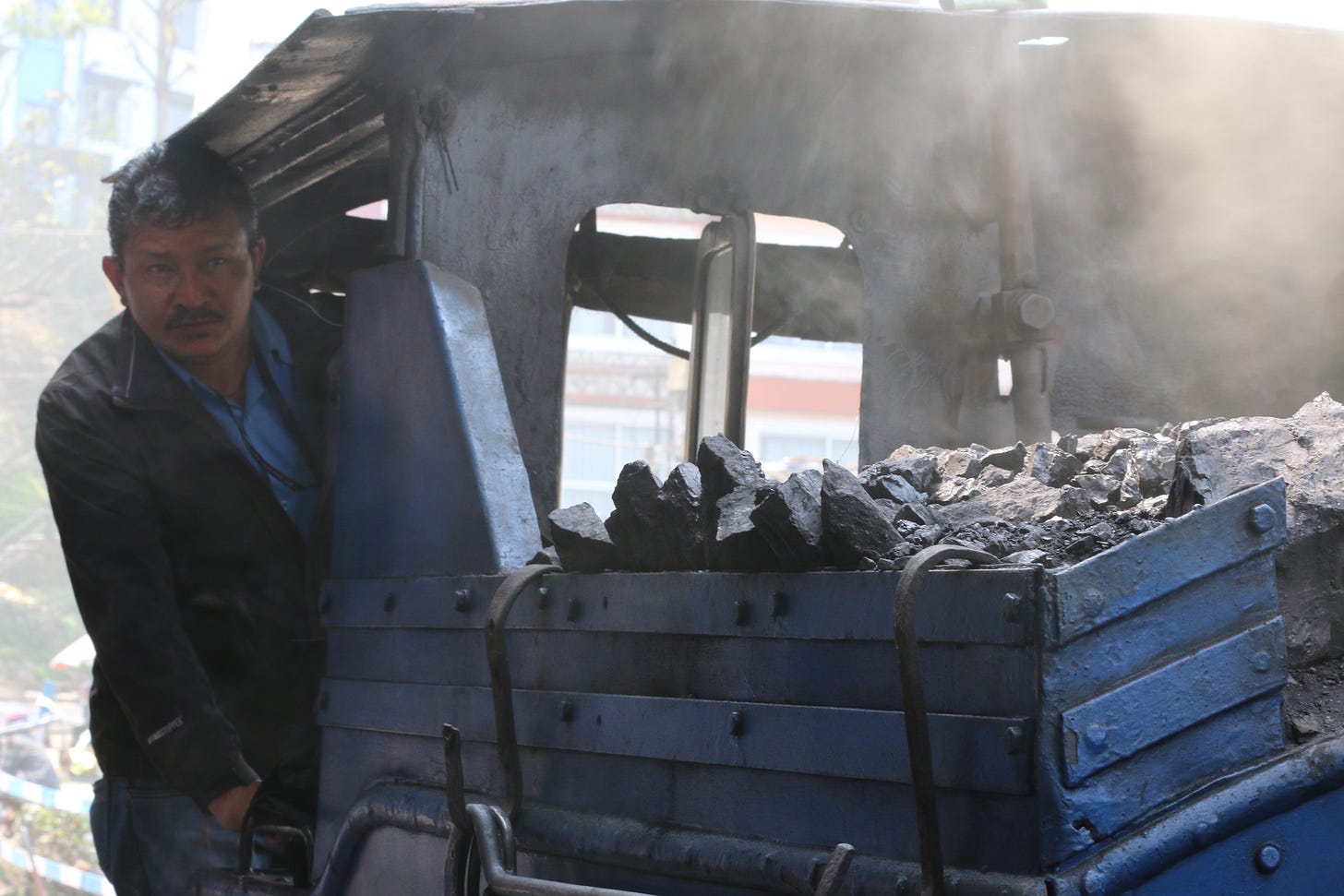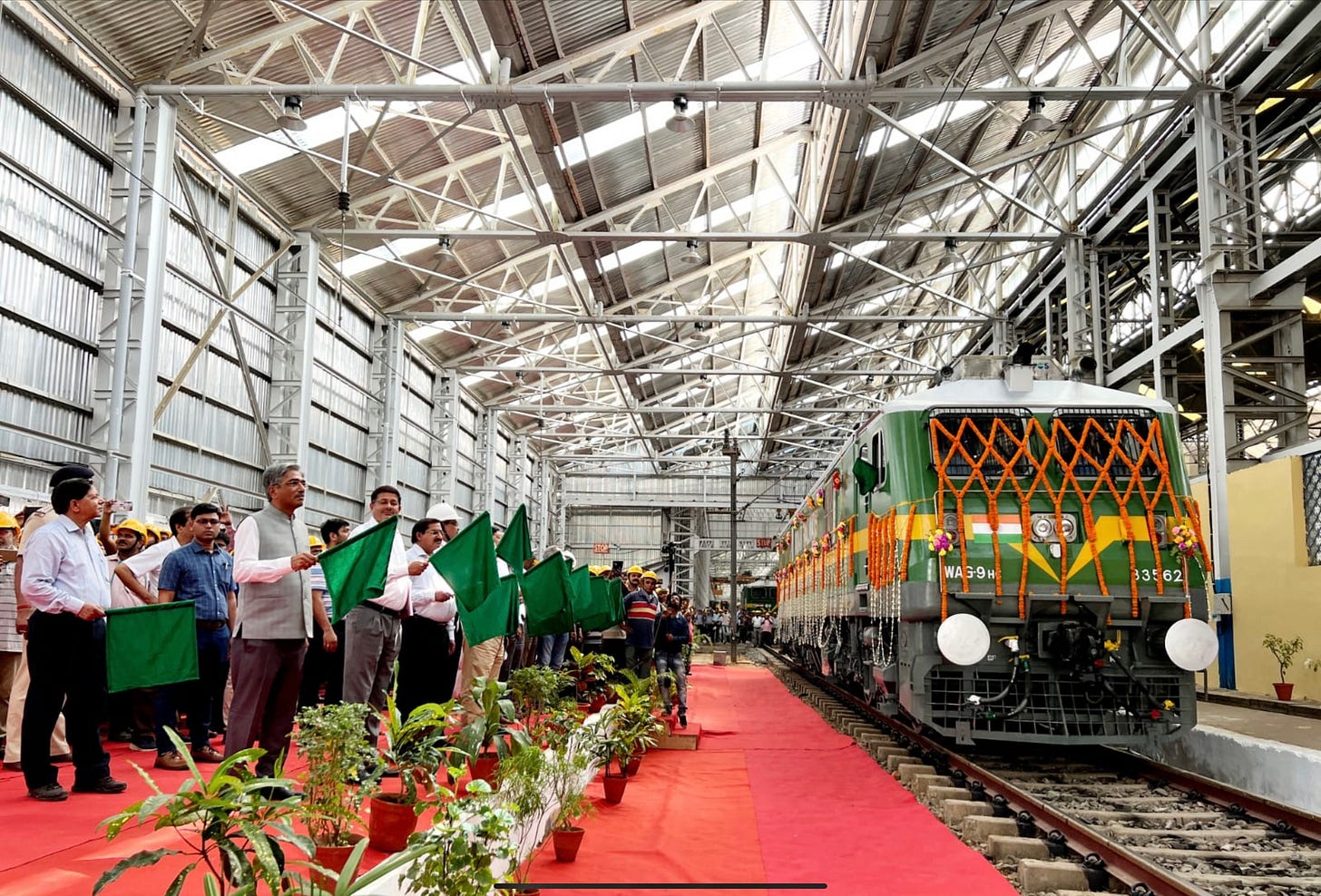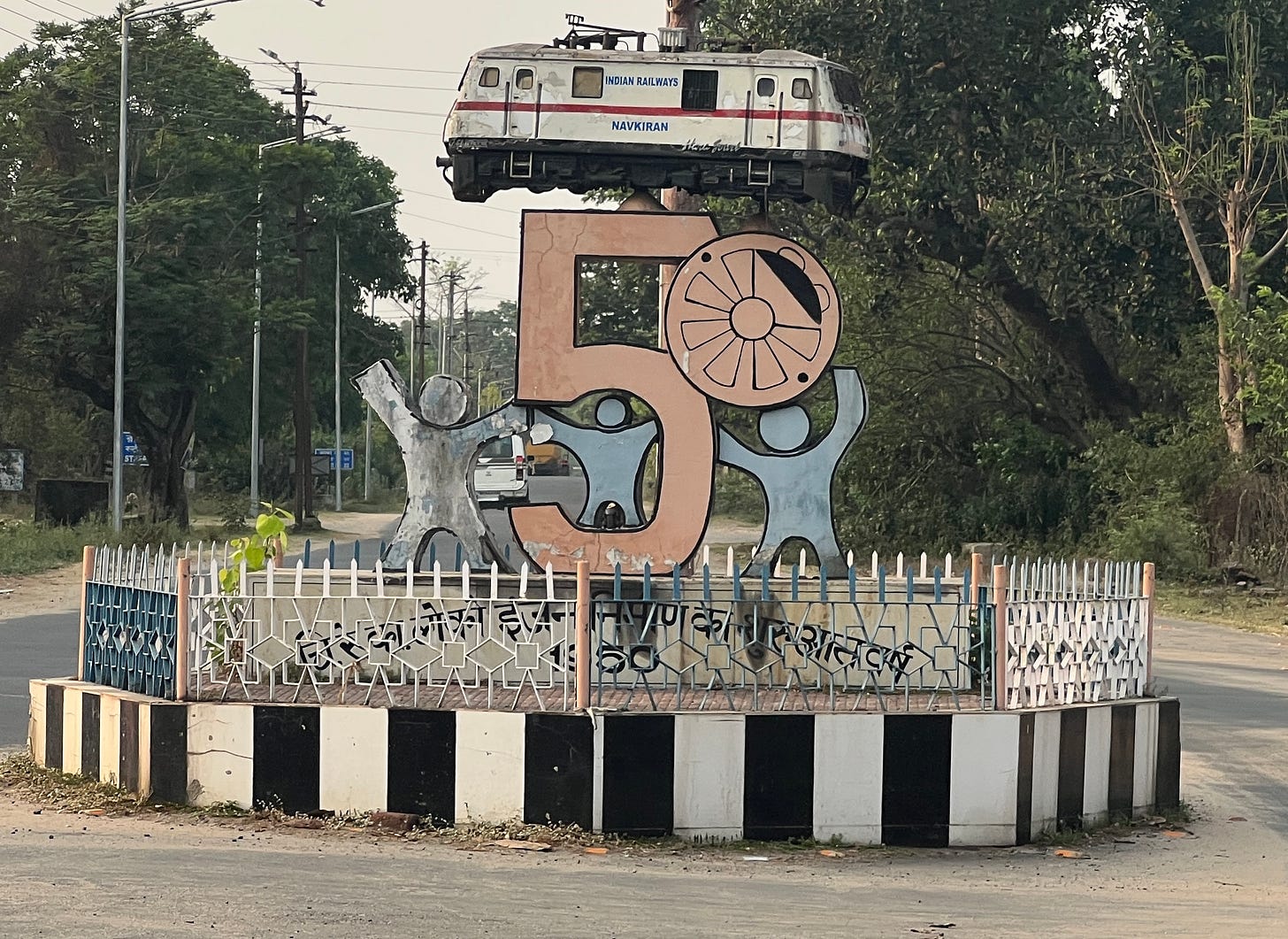Two Trains, One Transition
A ride on Darjeeling’s coal-fired train and a visit to India’s main electric locomotive factory illustrate the transition. Now it needs to make tracks in a hurry.
The brutal war in Ukraine and its reverberations across Europe are a long way from where my recent travels have taken me: the hills of Darjeeling, their slopes steeped in tea and nostalgia for the long-gone British Empire, and the fertile plain that spreads out between the city of Kolkata and the Himalayan foothills.
Yet my encounters with two trains, one in each place, resonated with the thorny energy dilemmas the world faces in responding to Russian aggression. Namely, how do economies, systems and societies transition from one energy source (say, imported coal and natural gas) to others (like domestically available solar, wind and nuclear power) in a damned hurry?
We’ve spent three posts looking at the impact of global warming on one of the world’s most vulnerable locales, the Sundarbans tidal estuary (read those here, here and here). Future posts will dig deeper into how other places in India are adapting and why adaptation is critical. But in this post I want to return to solutions — how to cut greenhouse gas emissions — echoing an urgent, massive report recently released by the leading global body on climate change.
The first train encounter took me back in time to India’s coal-fired, colonial past on a steam locomotive through the storied hills of Darjeeling. The second transported me forward toward modern India’s decarbonized future: riding (even a short stint driving!) an electric locomotive of the sort that increasingly dominates India’s rail network.
And what a rail network it is!
This post also serves to introduce the Indian Railways, one of the world’s most remarkable institutions. The railway figures prominently in my journey from here on out. It’s how I am making my way around the subcontinent, and it occupies an important role in India’s transition from coal to clean electricity. It’s an institution that touches almost every part of India and virtually every Indian in some way.
Among the oldest railroads in the world — and the first in Asia — Indian Railways transports more people, more places than any railway outside of China. Daily, that’s 23 million riders, along with 3 million tons of freight. It’s like moving all of Australia every 24 hours. Wholly owned by the government, Indian Railways operates 40,300 miles of tracks, enough to go around the earth and then some. It’s one of the world’s largest employers, with 1.5 million workers. Its lines reach nearly every corner of the country, piercing jungles, scaling mountains, tracing coastlines, sprawling across dense cities and traversing fertile rural plains. Passengers are from all walks, migrant laborers traveling to and returning home from far away jobs, bureaucrats making their daily commute, farmers toting produce to city bazaars, inspectors bound for rural villages, soldiers commissioned to far-flung posts and the pious on the country’s never-ending pilgrimage circuit. Railway freight is the lifeblood of the economy: grains and lentils, kernels and bulbs, clothes and textiles, appliances, cement, chemicals, cars, coal.
Indian Railways is also the largest single energy consumer in India, as recently as 2017 guzzling up as much as 2.6 billion liters of diesel fuel and 18 trillion watts of power a year. That’s more than 3% of the country’s entire consumption of diesel and about 2% of its electricity. Were Indian railways a country, that sort of energy consumption would rank it among the top 100 consuming nations.
The history of the railway is the story of India becoming a modern nation. And to the extent the railway is a microcosm of India, it can help explain three things:
The inevitability of energy transition now that the incentives are in place.
Why transitions like these usually take so long and are so devilishly complicated.
How the transition can be accelerated.
So, all aboard!
With so much romance shrouding memories of the steam locomotive, it’s easy to forget why the first ones in India were dubbed “Fire Chariots.” There’s a small inferno in its belly, driving it. Though engineering feats for their time, these are seriously noisy, smoke belching, sooty, coal-dust-smeared machines.
That becomes obvious when you board a rail carriage behind one, as my wife, Michele, and I did in Darjeeling. We took what’s billed as the tourist “joy ride” from the former colonial hill town up to the city of Ghum, which hosts the highest train station in the world at 2,258 meters (7,407 feet). The line runs on track gauge so narrow that the locomotive is commonly referred to as the “Toy Train.” The locomotive and two cars cut a vertiginous path along ridges and through hillside towns and villages. Once the workhorses of India’s rail system, only a handful of steam locomotives operate today, all of them tourist attractions like the Darjeeling Himalayan Railway we rode. The line, launched in 1881, is a UNESCO World Heritage Site.
Eager riders packed into the two carriages pulled by our locomotive. The experience was certainly redolent of India’s colonial history, with the difference that it’s now fully owned, operated and, in these days of Covid, ridden almost entirely by Indians. But we could also understand the disappointment expressed by many a Trip Advisor reviewer that the line segment currently operating offers few majestic views — due to overbuilding along the tracks — and almost constant, ear-piercing whistle shrieks aimed at pedestrian and auto traffic on the road the train runs along.
This is an experience mainly for rail aficionados and connoisseurs of colonialism — as well, perhaps, as the occasional reporter looking for historical perspective on energy transition.
Coal-fired steam locomotives have become novelties for a reason: cleaner, cheaper, better technologies followed, replacing them. India imported its first diesel locomotive from the U.S. in 1957, ten years after it won its independence. And for decades diesel dominated India’s railways. Yet coal-fired steam hardly disappeared overnight. The last steam locomotive — dubbed the Antim Sitara, or “The Last Star” — was made in 1970. India retired its last working steam locomotive in 1995.
Nearly all the while, another contender was slowly rising: electric locomotives. The first in India rolled out of what was known as Victoria Terminus Station in Bombay in 1925. The first electric locomotive built in India was commisioned in 1961, only four years after the import of that first diesel locomotive.
But only quite recently has Indian Railways begun deploying electric locomotives at a record clip — because now they’re the cornerstone of the government’s plan to go green. By the end of this year, electric locomotives should be running on virtually all Indian Railways’ main lines. This is why I stopped outside Kolkata to visit the Chittaranjan Locomotive Works, India’s most storied locomotive plant.
CLW, as the factory and testing ground are known, built India’s first domestic steam locomotives. Before that, the Indian colonial administration, known as the Raj, imported all of them from mother ship Britain. CLW also made that first electric locomotive.
Chittaranjan is basically a company town — along the lines of Toyota City in Japan, the hometown of Toyota Motors, which I visited when I covered the Japanese auto industry in the 1990s. Except that while Toyota City is a bit of an industrialized car town, Chittaranjan remains an oddly bucolic enclave where close to 50,000 workers and their families live, attend school, and take part in all manner of community activities, from cricket to traditional Hindi language poetry.
The community was purpose-built, ordered up by India’s first prime minister, Jawaharlal Nehru, having helped throw off its colonial masters the previous year. Nehru visited several times, one of a parade of international notables who came for a look, including Ethiopian emperor Haile Selassie, Soviet leader Nikita Khrushchev, Chinese premier Chou En-Lai, Egyptian and Yugoslavian strongmen Gamal Abdul Nasser and Marshall Tito, even the Dalai Lama.
CLW just finished producing a record 486 locomotives in the past year, all of them electric. The company believes this could be more locomotives manufactured in a single plant in a year than ever in history — and plans to apply to the Guinness World Records to prove it. The company’s general manager, S.K. Kashyup, told me the factory plans make 540 more this year, about half of all the locomotives that will be made in India. The railway ministry, indeed the entire government, has made electrification of the railway a pillar of efforts to meet their goal to decarbonize the economy by 2070. So far, the railway has electrified about 85% of the most heavily used lines in the network. During my tour of the CLW’s cavernous workshop, I even drove one of these 125-ton electric locomotives (with a lifelong CLW test engineer at my side!). They are quiet, clean and remarkably easy to drive (at least for the roughly one-tenth of a mile I was at the helm!). By the end of next year nearly all major lines will be electrified.
So is mission go-green accomplished then?
This is where the devilish complexity starts. Electrifying the locomotives is only step one. To get India off coal, now come the hard parts. Since two-thirds of India’s overall electrical generation comes from coal, electrifying locomotives just swaps one fossil fuel, diesel, for another, the coal that creates the electricity. Phasing out coal from India’s energy mix is a much more difficult challenge, given the scale of total electricity demand and the tens of millions of Indian livelihoods that depend on the coal industry itself.
But if trains run on electricity, at at least that’s no longer Indian Railways’ problem, right? Unfortunately, the demise of coal will create another, almost bigger problem for Indian railways. Since its earliest days, coal has been the biggest and most profitable freight that the Indian railway carts around. Indeed, the railway overcharges for coal freight, so that it can undercharge for basic passenger fares. Indians tend to see this as both fair to legions of poor and lower-middle class riders and critical for an economy that incorporates a lots of domestic migrant labor requiring cheap travel.
As renewable energy pushes coal out of the power generation system, the corresponding drop in coal freight will eventually lead to big problems with railway finances.
Okay, you say, then just stop the cross-subsidization and make passenger fares reflect the cost of passenger travel? Well, that is easier said than done. This is because the railway is government owned, an essential public service and… India is a democracy. Every one of the 23 million daily riders — who don’t want to pay higher ticket fares — is a voter. As are all 1.5 million employees, many of whom belong to unions close to political parties.
You can see how all this gets very complicated for the politicians, who have a lot of influence over the railway. We’ll dig into some of that complexity — which runs through India’s entire energy economy — in future posts.
For now, suffice it to say this complexity is why energy transitions take so long, left to their own devices. Yet this energy transition must happen fast. It cannot be left to its own devices.
What new devices then? That’s where we come back to the critical, cross-border cooperation needed between the developed world — which has the capital needed to smooth out rocky adjustments such as these — and a developing world with entirely reasonable and growing energy demand.
Deals need to be made for the good of all. A radical step-up in investment from developed countries into the developing world is urgent and long overdue, not only in renewable energy but also to help phase out coal power generation in a hurry. Indian leaders are quietly realizing how much they’ll ultimately waste by pushing on with coal, but neither do they have the sums needed, up front, to retire coal generating plants early and keep up with power demand. Wealthy countries are, maybe, starting to grasp just how much it will cost later to address climate impacts from continued use of coal. Ultimately cheaper, definitely wiser, and simply the right thing to do, wealthy countries should fund now what developing countries cannot.
The benefit would be a gain for all. Otherwise, the toll on everyone will be far larger later.

